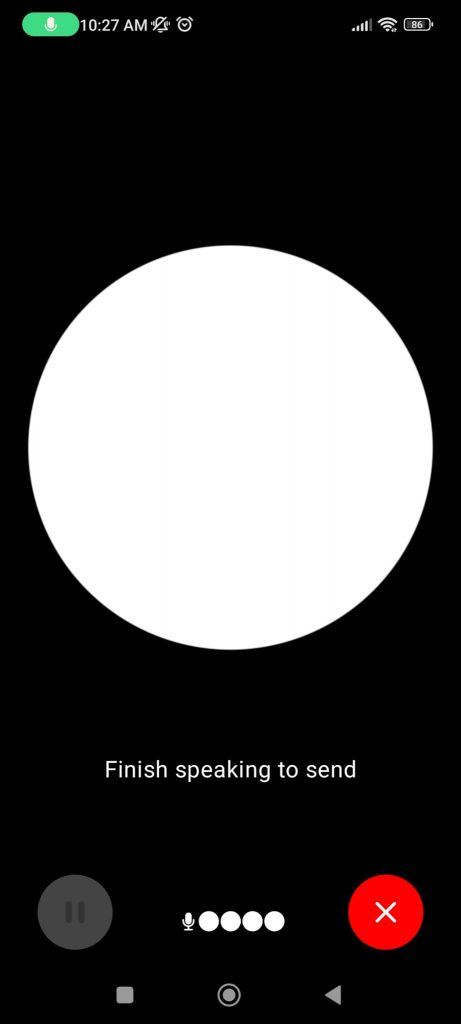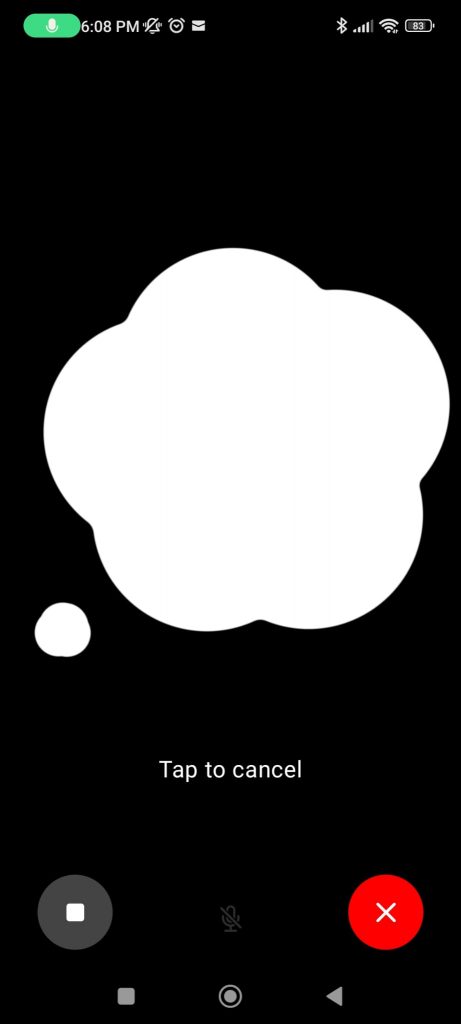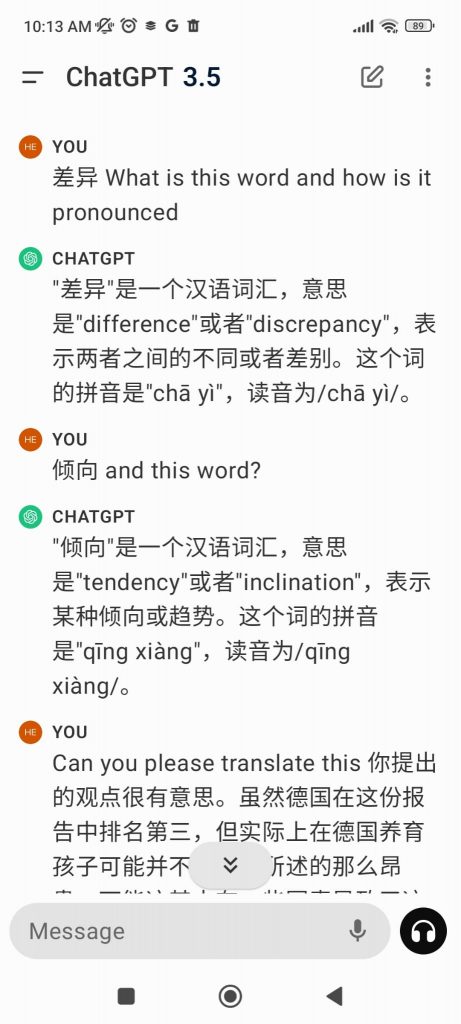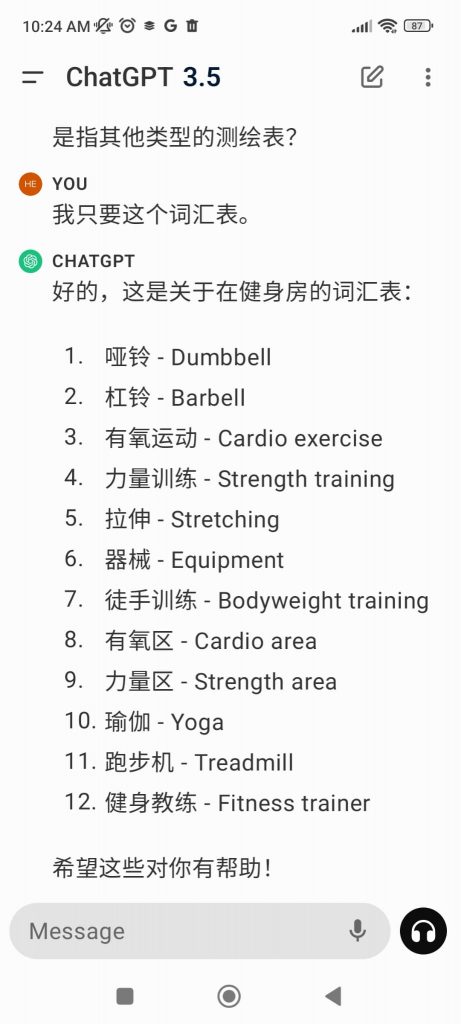
I have a new Chinese teacher. She is always available to teach me anytime, night or day, when I want to have a lesson (well, at least anytime I have a good cellular data or WiFi connection). She talks to me about any subject, asks me questions, offers me suggestions. She has great pronunciation in Mandarin, even though she is not a native speaker. She also speaks perfect English, should I require a translation of a word or sentence, and she can even switch instantly and effortlessly to French or any other languages I want to practice. She provides me with custom exercises based on conversations we’ve just had, and when I show her the Mandarin material which I’m working on in my Confucius Institute class, she helps me to prepare for my next lesson. And that’s not all: She also has four friends who speak in different voices, each with the same excellent Mandarin pronunciation, who are just as willing to help me learning my Chinese. And guess what? This amazing teacher is actually ChatGPT, the AI language model, and it’s a fantastic tool for learning Chinese!
How to use ChatGPT’s New Conversation mode for language learning
ChatGPT’s new spoken word AI conversation function is available for mobile iOS and Android devices. Just over a year ago at the end of 2022, the world was astounded by the capabilities of the newly launched ChatGPT and many people began integrating it into their lives and work. As a foreign language teacher (teaching English in Germany), I was immediately struck by the huge potential for this new AI technology to be integrated into the foreign language classroom as a teaching tool. For example, busy teachers can now effortlessly generate customized content for individual students, a task for which they would otherwise never have been able to find time.
The new speech mode of ChatGPT is equally amazing and features five uncannily natural sounding voices who speak many languages (almost) perfectly. I tested it with English, Chinese, French and German and was very impressed by its knowledge of the languages as well as by its friendly, natural-sounding tone, which integrates a lot of human-like inflections. I definitely didn’t feel like I was talking to a robot! As of March, 2024 this function can only be accessed via the mobile ChatGPT app and it’s (still) free of charge.
Why do you need an AI Conversation Partner to learn languages?
I’m a huge fan of language learning apps like Duolingo and Busuu. I find that these and other apps present language learning programs which are extremely well designed and which provide constant repetition, pronunciation practice, foundational grammar and listening opportunities. By investing about 15 minutes a day, it’s entirely possible to significantly improve your knowledge or even learn a language from scratch. However, the one thing that is missing from these apps is true speaking practice. Until now. With the advent of AI, an opportunity to truly speak and converse in the target language has become possible.
How to use to ChatGPT’s new speaking mode to practice Chinese
1. To start ChatGPT’s new speaking function, simply open the app and then click on the headphones icon.
2. Then you just begin speaking. ChatGPT recognizes natural breaks in the conversation and will begin speaking to you when you pause your flow of speech or ask a question. I usually start a chat session with ”ChatGPT你在吗“ (ChatGPT nǐ zài ma/ChatGPT are you there?).
3. You can exit the speaking mode any time you like by clicking on the X.
4. When you exit the speaking mode, a written record of your conversation will be revealed. You can long-click on this text, section by section, for different functions, e.g., to have it read back to you out loud.
5. In the settings, you can change ChatGPT’s AI voice to one of her four friends, each with the same natural sound and great Mandarin pronunciation.
ChatGPT is customizable. Here are just a few of the ways you can use this new AI function to learn Chinese:
1. Speak in Mandarin about any subject you want
We had many conversations on topics ranging from going to the gym to the best kinds of tea in China.
2. Ask for Mandarin Translations in English
If you don’t understand a word or sentence, ChatGPT can switch effortlessly to English (and many other languages as well).
3. Request Custom Vocabulary Lists
Ask ChatGPT to provide you with a vocabulary list about the words and vocabulary you just discussed. For example, I asked for a vocabulary list about gym equipment.
4. Upload Chinese texts so that you can discuss them
I was well-prepared for my last Mandarin class because I had uploaded our text to ChatGPT’s webpage and she helped me to clarify vocabulary, summarize the article and engage in a good discussion on the topic beforehand.
5. Ask ChatGPT to Give you Custom Exercises
Chat GPT will provide you with exercises on the topics you have just discussed. You can then upload your answers and it will correct them for you.
Other Large Language Models are not Quite Ready to Be Mandarin Tutors
I have tested the other main large language model chatbots – Google’s Gemini (formerly Bard), Microsoft’s Copilot, Meta’s Llama to see if they can also function as foreign language tutors. Unfortunately, the results were quite disappointing. They simply don’t speak a word of Chinese – at least not as of March, 2024. Of course, the problem might lie with my own pronunciation which perhaps is insufficient for these Chatbots to understand or perhaps my computer’s language and location settings (I live in Germany) prevented them from conversing with me in a foreign language.
Chat GPT seems to be the most well-developed large language model, at least with respect to its ability to teach foreign languages and serve as a personal Mandarin AI tutor.
Advantages of using ChatGPT for conversational Chinese:
1. Conversation Practice
You can speak directly and naturally to ChatGPT. You don’t have to concentrate on super clear or slow pronunciation. Likewise, ChatGPT can understand all levels of Mandarin. I tested her with my own level of Mandarin as well as with my husband’s, who hasn’t spoken much Chinese in 20 years. She was able to understand us both. She even regulated her tempo to match our abilities.
2. Pronunciation Modelling
The five voices offered by ChatGPT’s speaking function are all extremely natural sounding and their Mandarin pronunciation is very, very good. They will repeat a word, phrase or sentence as often as you like.
3. Written record
ChatGPT provides a written record of what you have just discussed (you have to pause the conversation and close the speaking window to reveal this text).
4. Can focus on specific sections of your conversation
Within this text you can highlight sections and have ChatGPT repeat the entire section out loud, allowing you to focus on pronunciation.
5. Customizable
You can ask ChatGPT to compile a list of the vocabulary, provide example sentences for vocabulary or give you language exercises on the topics you have just discussed. You can then use these for studying on your own or even submit your exercises for correction.
However, ChatGPT isn’t perfect. Here are some of the current deficiencies I discovered in ChatGPT’s Mandarin-teaching ability.
Disadvantages of using ChatGPT to practice Mandarin:
1. ChatGPT is not a language authority
ChatGPT will potentially make mistakes. One example of a mistake in English: We were discussing musical instruments in Chinese and I asked her about the “大提琴 Dàtíqín” – “cello”, which she pronounced (in English) with a soft “C” – “sell-o”. I corrected her and she thanked me and I congratulated myself on contributing to ChatGPT’s personal development. But she later made the very same mistake again!
2. Can’t Correct Pronunciation
Liaoliao claims to be able to help correct my pronunciation, but actually she can only speak and repeat but not evaluate if I make a mistake with, say, Chinese tones.
3. Doesn’t Always Get What I Want
Even though she can usually understand my pronunciation, it’s still sometimes frustrating to get her to do what I want, regardless of whether I am speaking Chinese or English. Getting her to follow instructions can somewhat tedious. For example, if I ask her for a list of the vocabulary we just discussed, she says “Sure!”, but then doesn’t provide it until I ask a second time.
4. Written Record Could be Better
ChatGPT provides a written record of what you have just discussed, however it’s not possible to view it at the same time you are speaking, but only after you have closed the speaking function. It’s also not possible to highlight individual words of this text to look up in Pleco or another digital dictionary. You can only copy and paste an entire section of text into your dictionary.
5. Speaking function Only Available in App
ChatGPT’s speaking function is only available in the app but not on the website. Therefore, using it to, e.g., upload a text which you want to discuss can become rather tedious if you first have to switch to your laptop, then go back to your phone.
There are a large number of other language-learning apps and tools which make good use of AI technology to help you learn Mandarin. Here are a few of the ones I have tested personally.
Other AI Language Teaching Apps and Tools to learn Chinese
1. Pleco and other Mandarin Dictionary Apps
Pleco, the Chinese, dictionary app, has been making use of AI for years. For example, its optical character recognition function allows users to snap photos Chinese characters in their textbooks or on street signs and look them up in the dictionary’s huge database. (This function is now also available on Google Lens and similar image search engines)..
2. Chrome Browser Extensions with Mandarin Pop-Up Dictionaries
These are very useful if you are working on your PC and reading a text in Chrome. If you highlight a word or phrase, a pop-up window provides a definition. There are several of these Chinese dictionaries offered on the Chrome store. The one I use is called Zhongzhong.
3. New AI Apps Specifically Designed to Train Language Speaking Practice
A variety of language-training apps have been developed which integrate AI functions. The most exciting of these provide a good platform for speaking practice. I tested two apps which I liked a lot. Tutor Lily, has the advantage of allowing you to view the text you have just spoken rather than having to close the speaking function as with ChatGPT. It also provides real-time corrections of what you have just said. TalkPalAI is another app which integrates AI technology to teach several languages including Chinese. It provides several conversation topics to get you started and also gives you real-time written text and corrections. However, both of these apps use robot voices which, while not bad, don’t give me the same feeling of talking to a friend which I get with ChatGPT.
Conclusion
The advent of ChatGPT’s new spoken word AI conversation function marks a significant advancement in language learning technology, particularly for Mandarin Chinese. ChatGPT offers personalized tutoring experiences, providing learners with instant access to conversation practice, translation assistance, vocabulary lists, and custom exercises. The convenience and flexibility of this AI technology make it a valuable tool for language learners, offering opportunities for speaking practice anytime, anywhere. While ChatGPT’s Mandarin-teaching ability has some limitations, such as occasional mistakes and difficulties in pronunciation correction, its innovative features and natural-sounding voices set it apart from other language-learning apps and tools. This is an extremely rapidly changing field and we can expect advancements and new apps to be making even better use of AI technology in the coming years, thus profoundly enhancing our language learning experiences.
Author
Heather Buchanan-Schrader

An unashamed language nerd from Anchorage, Alaska, Heather’s life has led her to a degree in German and International Studies from Willamette University and a three-year stay in Taiwan with her German husband at the end of the eighties. In Taipei she took intensive Chinese courses at the Mandarin Training Center of Taiwan Normal University and also taught English at the Taipei Language Institute. After the fall of the Berlin Wall in 1989, she became intrigued by the life in a former East Bloc country and finally decided to relocate to Leipzig, Germany in 1991. There she and her husband established the FAE Fachinstitut für Angewandtes Englisch, a private English institute focusing on teaching adults, translations and language coaching. This has been a successful venture for over 30 years.




























